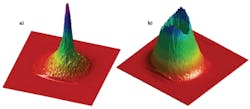REMOTE DETECTION: 'Backward laser' is formed in ordinary air
What could make the detection of gas leaks, explosives, or noxious chemicals at a distance easier than ever? One way would be to somehow create a laser remotely in the air at the point to be measured; the laser's emission would then contain the required chemical information. This is what researchers from Princeton University (Princeton, NJ) and Texas A&M University (College Station, TX) have now demonstrated.1
Their "backward laser" is a simple idea, and hinges on a coincidence of chemistry: The frequency of light needed to split molecular oxygen in air into two atoms of oxygen is very close to an atomic transition in those atoms. Focus the beam from a 226-nm-emitting laser down into a point somewhere in ordinary air and, through two different two-photon absorption mechanisms, both processes will occur—turning oxygen from the air into an emitter of light at 845 nm.
This process has been known for nearly 30 years, principally from spectroscopic studies of flames, in which atomic oxygen is just one of many chemical species. Princeton's Arthur Dogariu and his colleagues were studying that mechanism a few years ago when they happened across an interesting result. "When we were studying flames, we noticed the same laser that excites the atomic oxygen also creates atomic oxygen, but when we looked at it without the flame we were still getting a signal," he says.
The team has now gone on to show that the approach yields an atomic-oxygen laser at the focus, sending coherent 845 nm light along the direction of propagation of the excitation laser and, crucially, back toward it.
Two lasers make the excitation beam
The team created the tunable excitation pulses by mixing the outputs of titanium:sapphire and Nd:YAG lasers and doubling the output. The result is 100 ps pulses with about 100 μJ of energy per pulse at 226 nm. Dogariu explained that the experimental setup requires little else. "You just take a laser and focus it down and that's it," he notes. "That's what makes it nice."
What remained to determine was that the 845 nm light—detected at distances up to about a meter—was not just fluorescence, but was in fact laser emission. They showed this by careful study of the backward-propagating beam. First, the 845 nm pulses have a duration of less than 300 ps—orders of magnitude less than oxygen's fluorescence lifetime. What's more, the backward-propagating light is some 8000 times more intense back toward the excitation beam than, for instance, to the side of the induced laser, and shows familiar laser-beam profiles (see figure).
That lasers can be driven into existence at a distance is surprising enough, but Dogariu thinks the process can be co-opted for the difficult business of remote detection. In those studies, sensitivity is typically limited by the low numbers of photons that the target region scatters back toward a detector.
"We have made air lase in a remote place, and the idea is to have a source at the target that sends the information back to us, rather than waiting for the light at the target to come back to us at will," he says.
The idea would not be to measure a given target molecule's absorption of the 845 nm light but rather to examine how the presence of a given target molecule affects the lasing process itself. The team is currently in the lab examining how various target molecules change the nature of the emission they collect.
"We would love for this to work for 'trace detection,' but that requires being able to see very small amount of molecules," says Dogariu. "We're going to try first looking at different gases such as methane or propane that you might get with a gas leak, and we'll be looking at changes in the absorption or emission due to that gas."
Whether the method lends itself to the highest-precision remote sensing applications remains to be seen, but the fact that the induced backward laser has been spotted suggests it has been around a long time. "We had it a few years ago and didn't realize it—we used the same laser, so we must've had it then too," Dogariu said. "We just didn't look in the backward direction."
REFERENCE
1. Dogariu et al., Science, 331, 442 (2011); doi: 10.1126/science.1199492.
D. Jason Palmer | Freelance writer
D. Jason Palmer is a freelance writer based in Florence, Italy.
